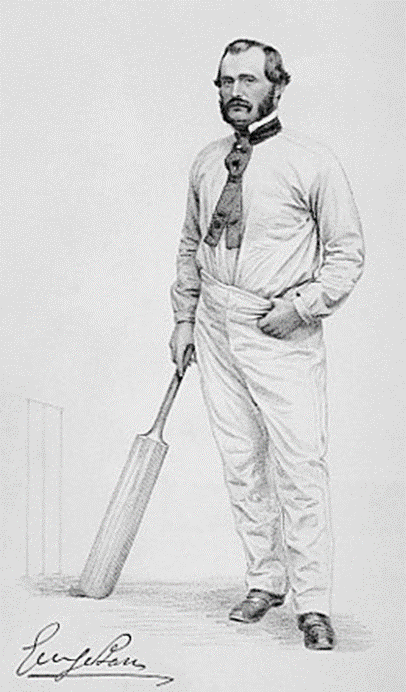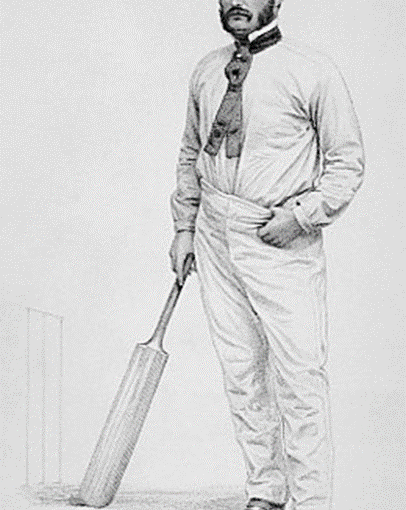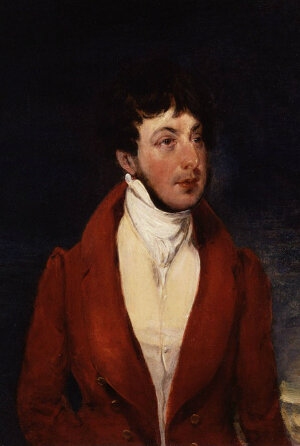Bendigo’s interest and involvement with the sport of cricket is well recorded. Not only was the man himself a capable cricketer, he was also a regular visitor to Trent Bridge cricket ground from its inception in the 1830s.
This was the decade that Bendigo’s boxing career took off, and Bendigo would have been somewhat of a celebrity who was always good entertainment. There is a story about Bendigo being at a match when a ball was hit and heading in his direction. He calmly removed his top hat and caught the ball using the hat, only for the ball to go straight through it, much to the amusement of the crowd.
Cricket At Trent Bridge
Nottingham Cricket Club is known to have played matches from 1771 and fifteen matches involving this side have been awarded first-class status. There was also a first-class match played by a combined Nottinghamshire and Leicestershire side in 1803. The first matches played as a Nottinghamshire side took place in 1829.
Nottinghamshire County Cricket Club was formally created in 1841, when William Clarke established Trent Bridge as a cricket venue adjacent to the public house he ran. It was Clarke’s successor as Nottinghamshire captain, George Parr, who first captained a united England touring team in 1859.
Bendigo Matched With George Parr
Bendigo’s cricketing ability is further enhanced by an invitation from George Parr to a challenge match one-on-one. George Parr was considered the best player in the world at the time.
Bendigo describes it in this article from BritishNewspaperArchive.co.uk

In this article Bendigo brags about his achievements.
‘I have also played and beat at cricket Gerland of Leeds, one of the great All England players at that time’.
Bendigo appears to have mixed up the name Girling with Crossland to make Gerland!
I was matched to throw a cricket ball and then play the then great All-England cricketer George Parr. The match did not take place on account of me being seized with gout.
Bendigo forgets to say that Parr graciously declined to claim forfeit.
George Parr is commemorated at Trent Bridge
Trent Bridge was first used as a cricket ground in the 1830s. The first recorded cricket match was held on an area of ground behind the Trent Bridge Inn in 1838 with Trent Bridge hosting its first Test match in 1899, with England playing against Australia.
The modern Trent Bridge ground has stands that commemorate William Clarke and George Parr.

George Parr’s first-class career lasted from 1844 to 1870. He was a big name in cricket and was known as the “Lion of the North”. He was a right-handed batsman and bowled occasional right-handed underarm deliveries. He played mainly for Nottinghamshire, and was club captain from 1856 to 1870 making occasional appearances for other counties and for Marylebone Cricket Club.
Parr was a stalwart of the All-England Eleven and was captain of the first England touring team, which went to North America in 1859. He also captained England’s unbeaten second tour to Australia and New Zealand in 1864.
Parr played in 207 first-class matches and had 358 innings, in 30 of which he was not out. Parr is widely considered as the best cricket player in the world in his time. He scored 6,626 runs (average 20.20) at a time when conditions greatly favoured bowlers. His highest score was 130 for Nottinghamshire, against Surrey at The Oval on 14 July 1859. He made 31 fifties and took 126 catches. He took 29 wickets in his career.
Reports About Bendigo Facing Arthur Girling

‘I have also played and beat at cricket Gerland of Leeds, one of the great All-England players at that time.
I was matched to throw a cricket ball and play the then All-England cricketer George Parr. The match did not take place on account of me being seized with gout.
The article is a good example of Bendigo’s unassailoble beief in his own sporting ability.
The following letter in response to the article gives more detail.

The match referred to was played at Alrewas on September 20th 1836.
Bendigo’s opponent was Arthur Girling, who went on to be a professional at Manchester.
In the match at Alrewas, Girling scored 3 and 4, and Bendigo 3 and 5 (not out).
Arthur Girling (1807 – 1849) was a first-class cricketer and umpire. He was born at Burton upon Trent and made his debut in first-class cricket for the North against the Marylebone Cricket Club (MCC) at Lord’s in 1841. He next played first-class cricket in 1845, when he appeared for Manchester against Yorkshire. He played cricket for Manchester until 1848, making six appearances. His best figures of 6 for 32 came against Sheffield in 1848, a match in which he took two five-wicket hauls. He also stood as an umpire in two first-class matches in 1840 and 1841. Girling died at Manchester in June 1849 at the age of 42.
Bendigo – The Bad Loser
There is also a report of Bendigo visiting Leeds in Yorkshire where he played a two-on-two at Woodhouse Moor. Bendigo easily beat a man named Ibbetson who was described as a ‘professor of the noble game’ and who played professionally around 1850. This win against Ibbetson allowed Bendigo (and a fielder) to play Mr J Holland and Andrew Crossland (a first class cricketer and umpire).

Crossland again went in and obtained 12 . The last ball he hit and run 2 for it, but just before Bendigo could field the ball, a dog started after it and Bendy, finding he had got too good a customer, walked off the ground, saying that he had not come to play dogs at cricket.
Andrew Crossland (1816 – 1902) was active from 1844 who played for Sheffield Cricket Club. Born in Dalton, Huddersfield, he died in November 1902 in Hull. His son Samuel Crossland also played first-class cricket
The Top-Hat Story
This story featured in a 1903 copy of the Evening Star. The game in question is suggested to be 1847 and at Trent Bridge where George Parr was playing.
It was etiquette to wear a top-hat at cricket matches. Before the game, the batsman were practicing, and one of them hit a ball towards Bendigo who was described as a fine athlete and a great cricketer. Bendigo was described as more than capable of catching the ball, removed his hat to preserve his hands and attempted to catch the ball using his hat. However, the ball went straight through – to the amusement of the crowd.

George ‘The Squire’ Osbaldeston
We shouldn’t finish without mentioning George Osbaldeston, a first class cricketer (as well as Member of Parliament for East Retford) who played professionally for Marylebone Cricket Club, Surrey, Sussex, and Hampshire.
He also took on the unenviable task of refereeing the third fight between Bendigo and Ben Caunt in 1845, the one that was described as ‘the most scandalous brawl in boxing history.
George Osbaldeston was the classic sporting hero of the period. The Cricket Mash blog describes him as ‘a versatile all-round sportsman, compulsive gambler and life-long philanderer. He was one of the most colourful characters of early cricket’.
Born in 1787 to a wealthy family, Osbaldeston went from Eton to Brasenose College.
In the same year he had his famous duel with Lord George Bentinck. Osbaldeston putting a bullet through his opponent’s hat within two inches of the brain.
Known as ‘The Squire’, Osbaldeston was a High Sheriff of Yorkshire and for six years M.P. for East Retford.
He died in 1866, leaving no heir, just his reputation.
Thanks to BritishNewspaperArchive.co.uk for the articles featured here.

